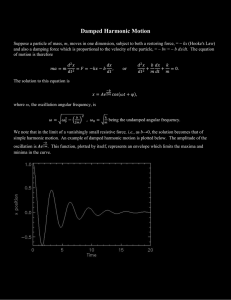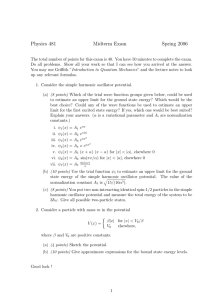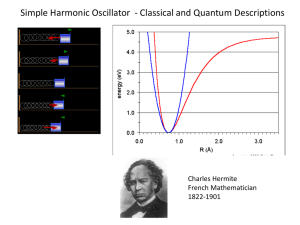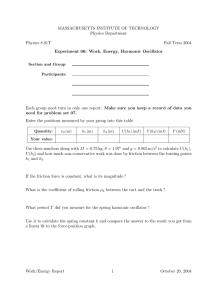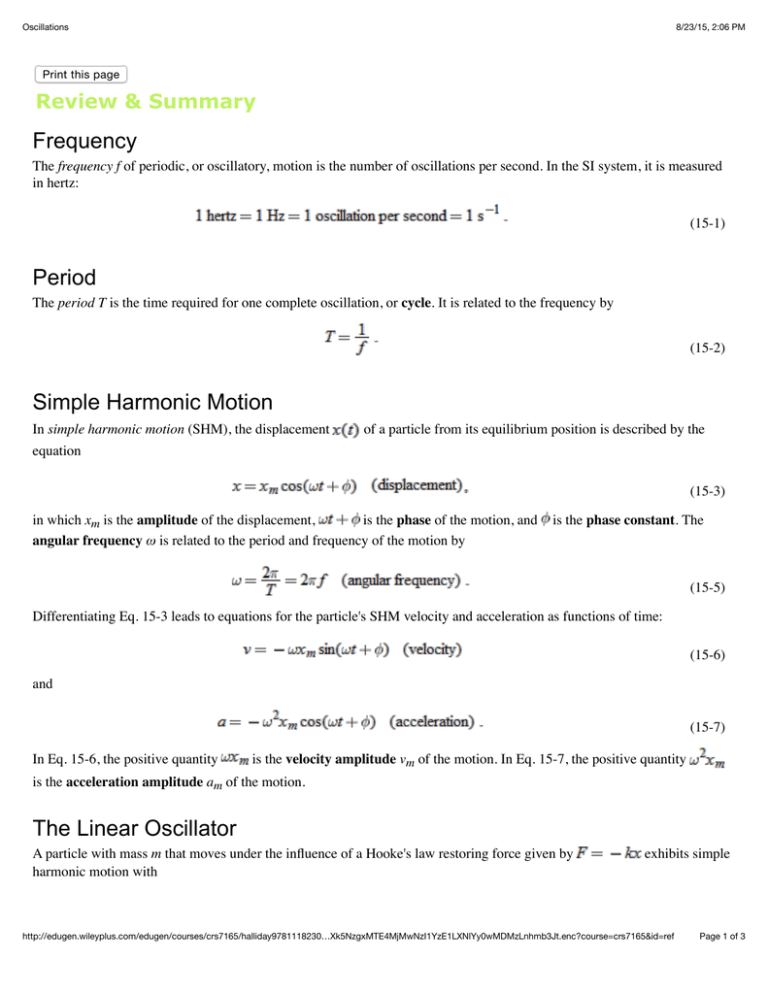
Oscillations
8/23/15, 2:06 PM
Print this page
Review & Summary
Frequency
The frequency f of periodic, or oscillatory, motion is the number of oscillations per second. In the SI system, it is measured
in hertz:
(15-1)
Period
The period T is the time required for one complete oscillation, or cycle. It is related to the frequency by
(15-2)
Simple Harmonic Motion
In simple harmonic motion (SHM), the displacement
of a particle from its equilibrium position is described by the
equation
(15-3)
in which xm is the amplitude of the displacement,
is the phase of the motion, and
angular frequency ω is related to the period and frequency of the motion by
is the phase constant. The
(15-5)
Differentiating Eq. 15-3 leads to equations for the particle's SHM velocity and acceleration as functions of time:
(15-6)
and
(15-7)
In Eq. 15-6, the positive quantity
is the velocity amplitude vm of the motion. In Eq. 15-7, the positive quantity
is the acceleration amplitude am of the motion.
The Linear Oscillator
A particle with mass m that moves under the influence of a Hooke's law restoring force given by
harmonic motion with
exhibits simple
http://edugen.wileyplus.com/edugen/courses/crs7165/halliday9781118230…Xk5NzgxMTE4MjMwNzI1YzE1LXNlYy0wMDMzLnhmb3Jt.enc?course=crs7165&id=ref
Page 1 of 3
Oscillations
8/23/15, 2:06 PM
(15-12)
and
(15-13)
Such a system is called a linear simple harmonic oscillator.
Energy
A particle in simple harmonic motion has, at any time, kinetic energy
friction is present, the mechanical energy
and potential energy
. If no
remains constant even though K and U change.
Pendulums
Examples of devices that undergo simple harmonic motion are the torsion pendulum of Fig. 15-9, the simple pendulum of
Fig. 15-11, and the physical pendulum of Fig. 15-12. Their periods of oscillation for small oscillations are, respectively,
(15-23)
(15-28)
(15-29)
Simple Harmonic Motion and Uniform Circular Motion
Simple harmonic motion is the projection of uniform circular motion onto the diameter of the circle in which the circular
motion occurs. Figure 15-15 shows that all parameters of circular motion (position, velocity, and acceleration) project to the
corresponding values for simple harmonic motion.
Damped Harmonic Motion
The mechanical energy E in a real oscillating system decreases during the oscillations because external forces, such as a
drag force, inhibit the oscillations and transfer mechanical energy to thermal energy. The real oscillator and its motion are
then said to be damped. If the damping force is given by
, where
is the velocity of the oscillator and b
is a damping constant, then the displacement of the oscillator is given by
(15-42)
where
, the angular frequency of the damped oscillator, is given by
http://edugen.wileyplus.com/edugen/courses/crs7165/halliday9781118230…Xk5NzgxMTE4MjMwNzI1YzE1LXNlYy0wMDMzLnhmb3Jt.enc?course=crs7165&id=ref
Page 2 of 3
Oscillations
8/23/15, 2:06 PM
(15-43)
If the damping constant is small
, then
, where ω is the angular frequency of the undamped oscillator.
For small b, the mechanical energy E of the oscillator is given by
(15-44)
Forced Oscillations and Resonance
If an external driving force with angular frequency ωd acts on an oscillating system with natural angular frequency ω, the
system oscillates with angular frequency ωd. The velocity amplitude vm of the system is greatest when
(15-46)
a condition called resonance. The amplitude xm of the system is (approximately) greatest under the same condition.
Copyright © 2014 John Wiley & Sons, Inc. All rights reserved.
http://edugen.wileyplus.com/edugen/courses/crs7165/halliday9781118230…Xk5NzgxMTE4MjMwNzI1YzE1LXNlYy0wMDMzLnhmb3Jt.enc?course=crs7165&id=ref
Page 3 of 3




